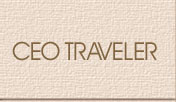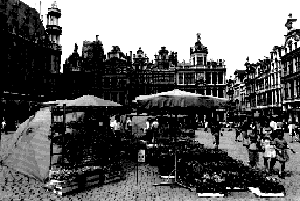 |
|
|
|
|
|
|
|
|
|
|
|
|
|
|
|
|
|
|
|
|
|
|
|
|
|
|
 |
 |
|
|
|
|
|
|
|
|
|
|
|
|

|
Belgium
Crossroad of Europe Even if it's not Tuesday, you will know the moment you arrive in Belgium. For this little triangle, wedged between the Netherlands, France, Germany and Luxembourg, with its perfectly preserved medieval cities, waterways arched with bridges and trees and colorful outdoor markets, is a Brueghel painting come to life. As home to NATO, the Common Market and Benelux Union this enchanting plot of land, approximately the size of Maryland, is also where the fate of modern Europe, if not the entire world, has often been debated and decided. It is the country that saw the defeat of Napoleon at Waterloo, but was occupied and trampled by the German invaders in both World Wars. It is where Gothic spires look down upon lavish baroque guild houses and turn-of-the-century Art Nouveau architecture was born. It is tranquil canals and serene landscapes, bustling cities and business, industry and culture. It is a rare mix of the ancient and the contemporary. But most of all, Belgium is civility, safety and one of Europe's most irresistible countries.
Getting around Belgium is as easy as un, deux, trois. Train service is superb and you can travel from east to west in less than three hours. But why hurry when each city has its own charm and distinct personality? Brussels should be every visitor's first stop. Not only is it the capital of Belgium, but it is the official capital of Europe. Since it is home to several hundred international organizations, you can expect a high level of sophistication and service. And because business and pleasure have been known to mix, the outstanding cuisine and deluxe accommodations come as no surprise. The Grand Place (Grote Markt), the city's hub, is reputed to be Europe's most exquisite square. Dating back to the 12th century, it is as astonishingly beautiful when the sun first reflects its golden façade as it is at night when it is bathed in moonbeams. It holds the riotously colorful bird and flower market on Sunday mornings. Fringing the square are guild houses; the magnificent 15th-century King's House, which sits on the site of a 13th-century bread market and is now the Municipal Museum; the Brewery Museum, located in the cellar of the Guild House of Belgian Brewers; and the Town Hall with its soaring spires topped by a statue of Michael, the patron saint of Brussels. There are dozens of restaurants and shops harmoniously tucked into the guild houses and visitors thoroughly intoxicated by the square have been known to wile away hours sitting at the tiny tables or simply wandering about. It is, however, odd to imagine a sophisticated city with more than 70 museums, several Michelin-star restaurants and the world's finest chocolates and lace celebrating a small bronze statue of a little boy relieving himself. But like Copenhagen's Little Mermaid, Belgium's Manneken-Pis, just a minute's walk from the Grand Place, is the country's logo. It is perhaps a testament to the sense of humor of the Belgians, their lack of pretension and their charm. No visit would be complete without a glimpse of this famous citizen. After two days of roaming the quaint and narrow streets and eating and drinking yourself silly at the astonishing restaurants and cafes of Brussels it is time to take an hour-long train ride to Bruges, one of Europe's best preserved and most picturesque medieval cities. Although Bruges has several museums and cathedrals (the Church of Our Lady has a white marble "Madonna and Child" by Michaelangelo), it would be reasonable to say that this dazzling city is a museum without a ceiling. During medieval times Bruges was the premier metropolis of northern Europe. Fortunately, it was caught in a time warp, for today it is a rare window of the past. Its cobblestoned streets fronted by vine-covered, step-gabled brick buildings, beautiful squares and quaint bridges crossing the canals like ribbons should be explored on foot or in a horse-drawn carriage. Visit the Markt (Market) dominated by the Belfry with its famous octagonal tower, the 13th-century halls adorned with statues and bas-reliefs depicting biblical and historical scenes and the Beguinage where the present occupants, Benedictine nuns, still wear original 15th-century vestments. And don't miss the exquisite lace shops dotting the city. Ghent, which can be visited before or after Bruges or on a separate day trip, is the last of the trio of great art cities of Belgium. It will satisfy those who equate castles, dungeons and moats with medieval life. There is also the splendid Cathedral of St. Bravo with the multi-paneled Van Eyck painting, "The Adoration of the Lamb of God." Also not to be missed is the port city of Antwerp, birthplace of Peter Paul Rubens. A visit to his magnificent home will dispel the notion that all artists live unrecognized and die impoverished. Ruben's house contains his art, as well as works by his contemporaries. Several major pieces by Rubens can be found in the largest Gothic church in Belgium and Antwerp's major landmark, the Cathedral of Our Lady. Diamonds abound in Antwerp where 70 percent of the world's most precious stone is produced. You can watch craftsmen at work in Diamond Land or visit the Provincial Diamond Museum, which has exhibits plus a treasury of ancient and modern jewels. There are, of course, numerous places to make purchases. Belgium is a tiny hospitable country filled with medieval, Gothic and Renaissance treasures that mirror the past, an attitude that enjoys the present and a joyous anticipation of the future. It is a country with many faces and each one is filled with unbridled optimism and welcome. For further information, contact the Belgian Tourist Office, 220 East 42nd Street, Suite 3402, New York, NY 10017 . Tel. 212-758-8130. www.visitbelgium.com —Roberta Graff Where To Stay in Brussels The Royal Windsor is our choice for the best place to stay in Brussels. Situated near the Grand Place, it is ideally located in the heart of the city. A three-year renovation added a fitness club and increased the number of suites that along with the guest rooms have recently been individually and tastefully redecorated. Five function rooms are available for meetings and parties ranging from 12 to 230 participants. Andre Smit, chef of the hotel's "Les 4 Saisons," is a winner of numerous culinary awards including Best Chef of Belgium, 1989. One of the things we liked best about the Royal Windsor was the copious breakfast buffet featuring a delicious array of cheeses, fish, breads, pastries, crepes and more. Royal Windsor Hotel, 5 Rue Duquesnoy, 1000, Brussels, Belgium. Tel. 32 (2) 505-55-00, 800-223-6800, is one of The Leading Hotels of the World. Rates range from $315 to $383 for superior and deluxe rooms. Packages are available. www.lhw.com Flying To Belgium The service and food on Sabena, Begium's national airline, are exemplary. The gateway cities from the United States are New York, Boston, Chicago and Atlanta. Most of the fleet is made up of 747s where business class is located in the comfortable upper tier. Sabena is the only airline that flies from Brussels to Florence or Bologna. Recently we needed a seat for a family member on a sold-out Brussels to Florence flight. A reservations agent at Sabena searched through all 79 passenger names in the computer. She found one seat for which the payment deadline had passed and phoned us immediately. SabenaHouse (SH) Box/1, National Airport, 1930 Zaventem, Belgium. Tel. + 32 2 723.86.00, + 32 2 723.50.20. www.sabena.com Fall 1994 |
||||
